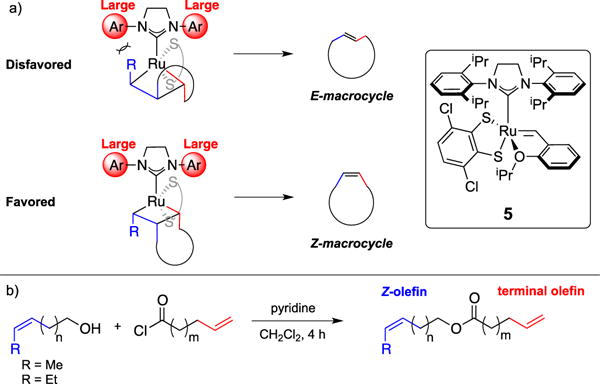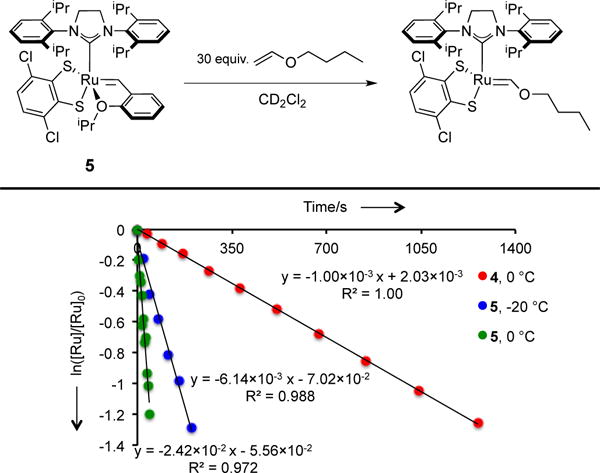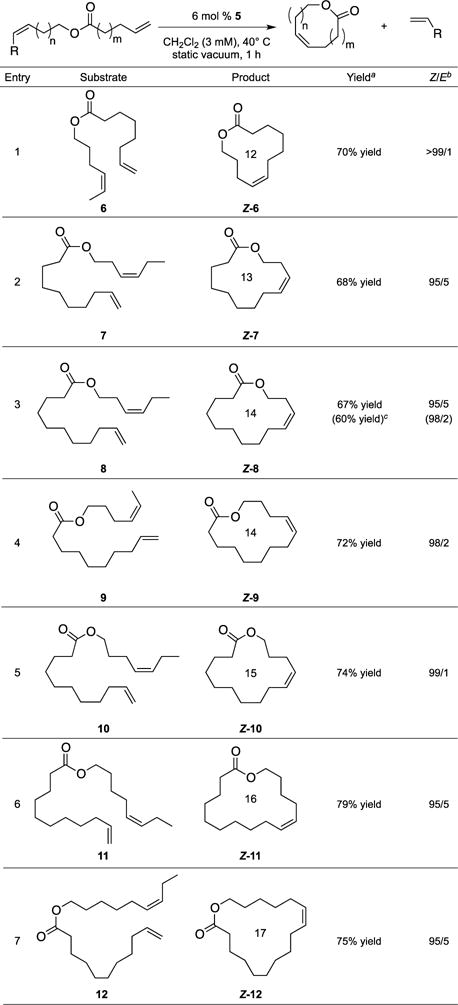Abstract
A highly efficient, Z-selective ring-closing metathesis system for the formation of macrocycles using a stereoretentive, ruthenium-based catalyst supported by a dithiolate ligand is reported. This catalyst is demonstrated to be remarkably active as observed in initiation experiments showing complete catalyst initiation at –20 °C within 10 min. Macrocyclization reactions generated Z-products from easily accessible diene starting materials bearing a Z-olefin moiety. This stereoretentive approach provides a more efficient and selective route to Z-macrocyles than in previously reported systems. Reactions were completed in appreciably shorter reaction times, and turnover numbers of up to 100 could be achieved. Macrocyclic lactones ranging in size from twelve-membered to seventeen-membered rings are synthesized in moderate to high yields (68 – 79% yield) with excellent Z-selectivity (95% – 99% Z).
Keywords: macrocycle, metathesis, Z-selective, stereoretentive, ruthenium
Graphical abstract

Transition-metal catalyzed ring-closing metathesis (RCM) has become a powerful method for generating cyclic molecules.1 It is widely used in the synthesis of pharmaceuticals as well as in the production of pheromones and musks as replacements for toxic, synthetic polycyclic and nitroarene musks.2 The stereochemistry of the alkene, E or Z, in these cyclic structures is often crucial to the biological activity of a molecule or its olfactory characteristics, and small amounts of impurity of the other stereoisomer in chemical mixtures can drastically decrease their potency. It is often particularly difficult to separate E- and Z-isomers as techniques for their separation are not general. As such, methods for producing stereochemically pure cyclic compounds are of paramount importance.
Controlling olefin stereochemistry in RCM reactions can be difficult. When using common non-selective metathesis catalysts, selectivity is controlled by the thermodynamic stability of the olefin products and can vary depending on ring size and double bond position.3 Because of the dilute conditions required to prevent oligomerization, high catalyst loadings are often needed for macrocyclization reactions using RCM, but removing residual metals can be challenging. For some applications, this requires further purification with lead or phosphine additives or with multiple chromatographic columns followed by treatment with charcoal.4 Reducing catalyst loadings required for these reactions is thus an important goal.
One established method for stereoselectively generating Z-macrocycles is ring-closing alkyne metathesis followed by Lindlar hydrogenation.5 Z-macrocycles have also been synthesized by reaction of terminal olefins with internal vinyl silanes followed by protodesilylation.6 However, these approaches require multiple steps to synthesize the desired product, and thus more direct methods using olefin metathesis are desirable. In 2011, the first report of Z-selective RCM was disclosed. Mo- and W-based catalysts 1–3 were used to synthesize a 16-membered macrocyclic lactone (91 – 95% Z), nakadomarin A (90 – 97% Z), and epothilone C (69 – 97% Z).3e While these catalysts afforded exceptional selectivity, they required catalyst loadings of 5 to 6 mol %. One year later, Z-selective cyclometallated ruthenium-based catalyst 4 (7.5 mol %) was reported to generate macrocyclic lactones, lactams, and ketones (75 – 94% Z) with the purpose of synthesizing pheromones and fragrances.2f This method was limited by long reaction times, required the use of high boiling solvents and elevated temperatures, and delivered most products with ca. 85% Z-selectivity.
In 2015, Hoveyda reported cross metathesis of Z-olefins and terminal olefins to generate highly Z-products (>96% Z) using Ru-based complexes supported by dithiolate ligands.7 Additional studies of these catalysts in 2016 demonstrated that they were highly stereoretentive, also capable of cross metathesis between two E-olefins or between an E-olefin and a terminal olefin to deliver products with kinetic E-selectivity (>98% E).8 The proposed model for Z-selectivity using these catalysts is based on a proposed side-bound metallacyclobutane intermediate in which stereoselectivity arises from the α-substituents of the metallacyclobutane favorably positioned away from the large N-aryl groups of the N-heterocyclic carbene (NHC) ligand (Figure 2). Given that the reacting olefin has Z-stereochemistry, the β-substituent points down in the favored proposed intermediate. Subsequent cycloreversion of this metallocyclobutane intermediate leads to the formation of the Z-product.
Figure 2.

Model for Z-selectivity using stereoretentive metathesis catalysts in cross metathesis.
Based on this model for selectivity, it was expected that highly Z-selective RCM to generate Z-macrocycles could be possible from diene substrates containing a Z-olefin and a terminal olefin using these catalysts (Figure 3a). These substrates are easily synthesized in high yield by reaction of commercially available Z-hydroxy olefins with alkenoyl chlorides (Figure 3b). Substrates were designed such that RCM of these substrates would give the desired product as well as a gaseous byproduct, propylene or 1-butene, which could be readily removed from the reaction mixture under static vacuum.
Figure 3.

(a) Proposed disfavored and favored metallacyclobutane intermediates in macrocylization reactions implementing stereoretentive catalyst 5 (b) Synthesis of diene substrates from acyl chlorides and Z-hydroxy olefins.
For these reactions, catalyst 5, bearing an NHC with N-2,6-diisopropylphenyl groups, was chosen due to its remarkable activity in cross metathesis reactions of Z-olefins.7 To compare the initiation rates of 4 and 5, the reactions of butyl vinyl ether with each catalyst were monitored by 1H NMR (Figure 4). Under standard conditions at 30 °C,9 catalyst 5 had already fully initiated within the 15 s required to acquire the first spectrum, and thus a rate constant could not be determined. The reaction was then monitored at 0 °C and was completed within 2 min with 5 while 4 required 1.5 h. Values of kinit for 4 and 5 at this temperature were determined to be 1.00 × 10−3 s−1 and 2.42 × 10−2 s−1, respectively. Thus, there is an order of magnitude of difference in the initiation rates of these catalysts, krel = kinit5/kinit4 = 24.2. Furthermore, full initiation of 5 was remarkably complete at −20 °C within 10 min with kinit = 6.14 × 10−3 s−1.10 Negligible Fischer carbene formation could be observed using 4 at −20 °C. This stark difference in initiation rate is a direct reflection of the significantly greater activity of 5 compared to 4.
Figure 4.

Plot of ln([Ru]/[Ru]0) versus time for initiation experiments conducted with catalysts 4 and 5 at 0 °C and −20 °C monitored by disappearance of the benzylidene signal by 1H NMR. Plots remain approximately linear for three half-lives of the reaction.
RCM was then attempted using 5 and was shown to be possible using a variety of substrates, 6 – 12 (Table 1). Using a standard catalyst loading of 6 mol % often used in macrocylization reactions, reactions were completed within 1 h in dichloromethane under static vacuum at 40 °C. Twelve- to seventeen-membered rings were all synthesized with high Z-selectivity (95 – 99% Z) in moderate to high yields (68 – 79% isolated yield). Yuzu lactone, Z-7, is in high demand by the perfume industry and can be synthesized more rapidly and selectively using 5 than in previous reports.2f,11 Larger macrocyclic lactones, fifteen-membered to seventeen-membered rings, were synthesized in slightly higher yields than with smaller twelve- to fourteen-membered rings.
Table 1.
Synthesis of macrocyles using 5.

|
Yields shown are isolated yields.
Selectivity determined by gas chromatography. Selectivity of Z-7 and Z-8 can be determined by 1H NMR.
Reaction was run on a preparative scale.
Given the exceptional activity exhibited by 5 in initiation experiments and its high activity in macrocyclic RCM (turnover numbers, TON, of 11–13 were achieved using 6 mol % catalyst loading), the limit for the catalyst loading required for reaction was examined. Using 0.5 mol % 5, 50% conversion (TON of 100) was attained in the macrocyclization of 8 within 1 h as determined by observation of aliquots of the reaction by 1H NMR. With 1 mol % 5, complete conversion of the starting material to the macrocyclic product and a small amount of unidentified byproduct, possibly an oligomer of the starting material, was observed. This is significantly lower than reported catalyst loadings used for achieving high conversion in previously reported Z-selective macrocyclizations.
In summary, highly active, stereoretentive Ru-based catalyst 5 was used for generating highly Z-macrocycles (95 – 99% Z) from easily available diene substrates with a Z-olefin moiety. The exceptional activity exhibited by this catalyst was determined through initiation studies and showed that full catalyst initiation could be achieved at −20 °C within minutes. Twelve- to seventeen-membered macrocycles, including yuzu lactone, were synthesized using this method in moderate to high yields (67 – 79% yield). These reactions were completed in significantly shorter times, and the use of lower catalyst loadings than in previously reported Z-selective systems was shown to be possible with TON of up to 100. Further studies using stereoretention for E-selective macrocyclization are underway.
Supplementary Material
Figure 1.

Catalysts used previously to selectively generate highly Z-macrocycles.
Acknowledgments
Funding from the Office of Naval Research (N00014-14-1-0650), NIH (GM031332), and NSF (CHE-1502616) is acknowledged. T.S.A. recognizes NSF for support through a Graduate Research Fellowship. Any opinion, findings, and conclusions or recommendations expressed in this material are those of the authors and do not necessarily reflect the views of the National Science Foundation. The authors would like to thank M. A. Pribisko, W. J. Wolf, C. W. Lee, T. P. Montgomery, and N. F. Nathel for helpful suggestions. D. Vandervelde and W. J. Wolf are acknowledged for their help with initiation experiments. N. Torian and M. Shahgholi are thanked for their assistance with high-resolution mass spectrometry. Materia, Inc. is acknowledged for generous donations of 4.
Footnotes
Supporting information for this article is given via a link at the end of the document.
Experimental Section
Experimental details are provided in supporting information.
References
- 1.Grubbs RH, Wenzel AG, O’Leary DJ, Khosravi E, editors. Handbook of Metathesis. Wiley−VCH; Weinheim: 2015. [Google Scholar]
- 2.(a) Michrowska A, Wawrzyniak P, Grela K. Eur J Org Chem. 2004:2053. [Google Scholar]; (b) Rimkus GG. The Handbook of Environmental Chemistry. 3X Springer: Berlin; 2004. [Google Scholar]; (c) Rowe DJ. Chemistry and Technology of Flavors and Fragrances. Blackwell; Oxford, U.K: 2005. [Google Scholar]; (d) Gradillas A, Perez-Castells J. Angew Chem, Int Ed. 2006;45:6086. doi: 10.1002/anie.200600641. [DOI] [PubMed] [Google Scholar]; (e) Ohloff G, Pickenhagen W, Kraft P. Scent and Chemistry: The Molecular World of Odors. Verlag Helvetica Acta; Zürich: 2011. [Google Scholar]; (f) Marx VM, Herbert MB, Keitz BK, Grubbs RH. J Am Chem Soc. 2013;135:94. doi: 10.1021/ja311241q. [DOI] [PMC free article] [PubMed] [Google Scholar]; (g) Higman CS, Lummiss JAM, Fogg DE. Angew Chem Int Ed. 2016;55:3552. doi: 10.1002/anie.201506846. [DOI] [PubMed] [Google Scholar]
- 3.(a) Fürstner A, Langemann K. J Org Chem. 1996;61:3942. doi: 10.1021/jo960733v. [DOI] [PubMed] [Google Scholar]; (b) Fürstner A, Langemann K. Synthesis. 1997:792. [Google Scholar]; (c) Goldberg WPD, Hobber AS, Weiler L. Tetrahedron Lett. 1998;39:4955. [Google Scholar]; (d) Lee CW, Grubbs RH. Org Lett. 2000;2(14):2145. doi: 10.1021/ol006059s. [DOI] [PubMed] [Google Scholar]; (e) Yu M, Wang C, Kyle AF, Jakubec P, Dixon DJ, Schrock RR, Hoveyda AH. Nature. 2011;479:88. doi: 10.1038/nature10563. [DOI] [PMC free article] [PubMed] [Google Scholar]
- 4.(a) Paquette LA, Schloss JD, Efremov I, Fabris F, Gallou F, Mendez-Andino J, Yang J. Org Lett. 2000;2:1259. doi: 10.1021/ol000036w. [DOI] [PubMed] [Google Scholar]; (b) Maynard H, Grubbs RH. Tetrahedron Lett. 1999;40:4137. [Google Scholar]
- 5.(a) Fürstner A, Mathes C, Lehmann CW. Chem Eur J. 2001;7:5299. doi: 10.1002/1521-3765(20011217)7:24<5299::aid-chem5299>3.0.co;2-x. [DOI] [PubMed] [Google Scholar]; (b) Nilson MG, Funk RL. Org Lett. 2010;12:4912. doi: 10.1021/ol102079z. [DOI] [PMC free article] [PubMed] [Google Scholar]; (c) Fürstner A. Angew Chem Int Ed. 2013;52:2794. doi: 10.1002/anie.201204513. [DOI] [PubMed] [Google Scholar]; (d) Fürstner A. Science. 2013;341:1229713. doi: 10.1126/science.1229713. [DOI] [PubMed] [Google Scholar]
- 6.Wang Y, Jimenez M, Hansen AS, Raiber EA, Schreiber SL, Young DW. J Am Chem Soc. 2011;133:9196. doi: 10.1021/ja202012s. [DOI] [PMC free article] [PubMed] [Google Scholar]
- 7.Koh MJ, Khan RKM, Torker S, Yu M, Mikus MS, Hoveyda AH. Nature. 2015;517:181. doi: 10.1038/nature14061. [DOI] [PubMed] [Google Scholar]
- 8.(a) Johns AM, Ahmed TS, Jackson BW, Grubbs RH, Pederson RL. Org Lett. 2016;18(4):772. doi: 10.1021/acs.orglett.6b00031. [DOI] [PubMed] [Google Scholar]; (b) Ahmed TS, Grubbs RH. J Am Chem Soc. 2017;139(4):1532. doi: 10.1021/jacs.6b11330. [DOI] [PubMed] [Google Scholar]; Stereoretention has been seen in metathesis previously; Bilhou JL, Basset JM, Graydon WF. J Am Chem Soc. 1977;99(12):4083. [Google Scholar]
- 9.Keitz BK, Endo K, Patel PR, Herbert MB, Grubbs RH. J Am Chem Soc. 2012;134(1):693. doi: 10.1021/ja210225e. [DOI] [PMC free article] [PubMed] [Google Scholar]
- 10.Substantial initiation of catalysts at low temperatures is often difficult using common metathesis catalysts; Romero PE, Piers WE, Mcdonald R. Angew Chem, Int Ed. 2004;43(41):6161. doi: 10.1002/anie.200461374. [DOI] [PubMed] [Google Scholar]
- 11.Alternative synthesis of yuzu lactone using alkyne metathesis; Fürstner A, Guth O, Rumbo A, Seidel G. J Am Chem Soc. 1999;121(48):11108. [Google Scholar]
Associated Data
This section collects any data citations, data availability statements, or supplementary materials included in this article.


